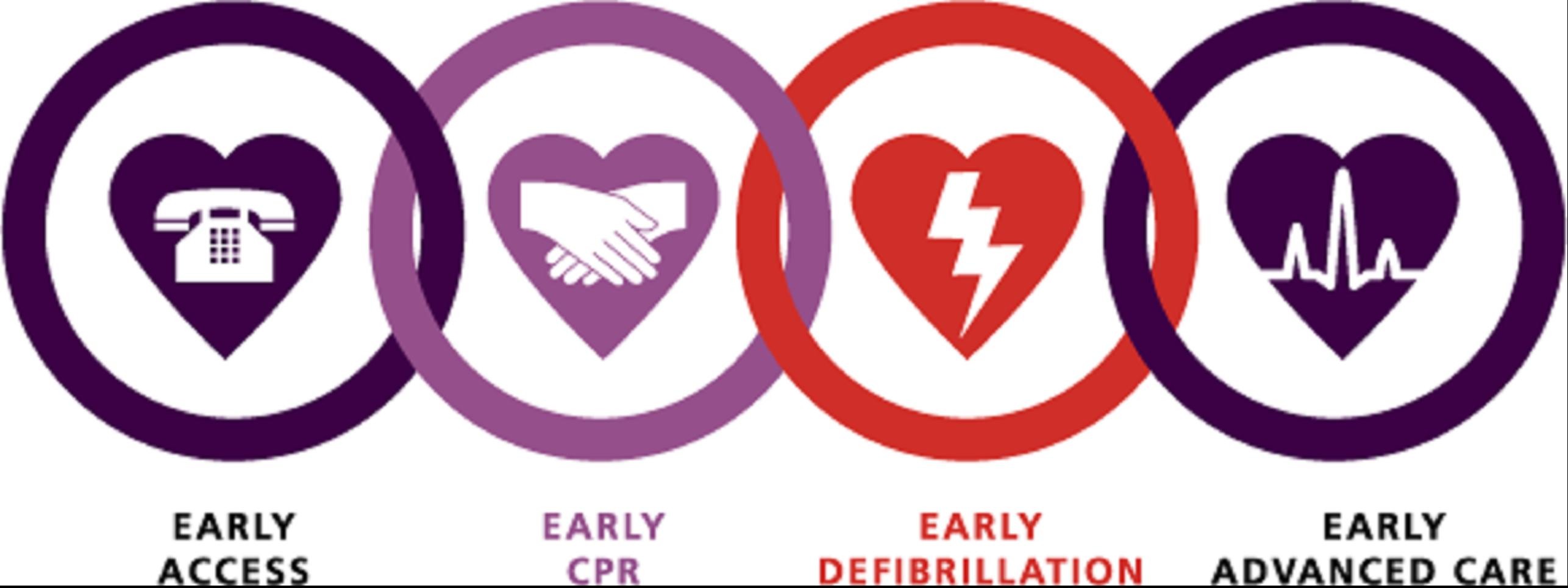Chain of survival
|
WikiDoc Resources for Chain of survival |
|
Articles |
|---|
|
Most recent articles on Chain of survival Most cited articles on Chain of survival |
|
Media |
|
Powerpoint slides on Chain of survival |
|
Evidence Based Medicine |
|
Cochrane Collaboration on Chain of survival |
|
Clinical Trials |
|
Ongoing Trials on Chain of survival at Clinical Trials.gov Trial results on Chain of survival Clinical Trials on Chain of survival at Google
|
|
Guidelines / Policies / Govt |
|
US National Guidelines Clearinghouse on Chain of survival NICE Guidance on Chain of survival
|
|
Books |
|
News |
|
Commentary |
|
Definitions |
|
Patient Resources / Community |
|
Patient resources on Chain of survival Discussion groups on Chain of survival Patient Handouts on Chain of survival Directions to Hospitals Treating Chain of survival Risk calculators and risk factors for Chain of survival
|
|
Healthcare Provider Resources |
|
Causes & Risk Factors for Chain of survival |
|
Continuing Medical Education (CME) |
|
International |
|
|
|
Business |
|
Experimental / Informatics |
Editor-In-Chief: C. Michael Gibson, M.S., M.D. [1]
Overview
The chain of survival refers to a series of actions that, when put into motion, reduce the mortality associated with cardiac arrest.[1][2] Like any chain, the chain of survival is only as strong as its weakest link.[1][2] The four interdependent links in the chain of survival are early access, early CPR, early defibrillation, and early advanced care.[1]

Etymology
The phrase "chain of survival" was first used as a slogan for the 1988 Conference on Citizen CPR.[3][4] It then appeared in JEMS editorial in August 1989, and the first issue of Currents in Emergency Cardiac Care in 1990.[3] The concept was elaborated in the American Heart Association's 1992 guidelines for cardiopulmonary resuscitation and emergency cardiac care,[5][6] and then echoed by the International Liaison Committee on Resuscitation (ILCOR) in 1997.[1]
Early access
Someone must witness the cardiac arrest and activate the EMS system[1] with an immediate call to 9-1-1[7] (or your local emergency number).
Early CPR
In order to be most effective, bystander CPR should be provided immediately after collapse of the patient.[1][8] Properly performed CPR can keep the heart in VF for 10-12 minutes longer.[2]
Early defibrillation
Most adults who can be saved from cardiac arrest are in ventricular fibrillation or pulseless ventricular tachycardia.[9] Early defibrillation is the link in the chain most likely to improve survival.[1] Public access defibillation may be the key to improving survival rates in out-of-hospital cardiac arrest,[1] but is of the greatest value when the other links in the chain do not fail.[2]
Early advanced care
Early advanced cardiac life support by paramedics is another critical link in the chain of survival.[1] In communities with survival rates > 20%, a minimum of two of the rescuers are trained to the advanced level.[1] In some countries, EMS delivery may be performed by ambulancemen, nurses, or doctors.[2]
See also
References
- ↑ 1.0 1.1 1.2 1.3 1.4 1.5 1.6 1.7 1.8 1.9 "Part 12: From Science to Survival - Strengthening the Chain of Survival in Every Community," Circulation 2000;102:I-358
- ↑ 2.0 2.1 2.2 2.3 2.4 Bossaert LL (1997). "Fibrillation and defibrillation of the heart". British journal of anaesthesia. 79 (2): 203–13. PMID 9349131.
- ↑ 3.0 3.1 "The Addition of the Fifth Link in the Chain of Survival to Include Myocardial Infarction," ChestPainCenters.org, Accessed July 11, 2007.
- ↑ "Chain of Survival: Converting a Nation," Citizen CPR Foundation, Accessed July 11, 2007.
- ↑ Cummins RO, Ornato JP, Thies WH, Pepe PE (1991). "Improving survival from sudden cardiac arrest: the "chain of survival" concept. A statement for health professionals from the Advanced Cardiac Life Support Subcommittee and the Emergency Cardiac Care Committee, American Heart Association". Circulation. 83 (5): 1832–47. PMID 2022039.
- ↑ "Guidelines for cardiopulmonary resuscitation and emergency cardiac care. Emergency Cardiac Care Committee and Subcommittees, American Heart Association. Part I. Introduction". JAMA. 268 (16): 2171–83. 1992. PMID 1404767.
- ↑ "Strengthening Each Link in the Chain of Survival," American Heart Association, Accessed July 10, 2007.
- ↑ Eisenberg MS, Bergner L, Hallstrom A (1979). "Cardiac resuscitation in the community. Importance of rapid provision and implications for program planning". JAMA. 241 (18): 1905–7. PMID 430772.
- ↑ "Early Defibrillation," Circulation 1997;95:2183-2184.